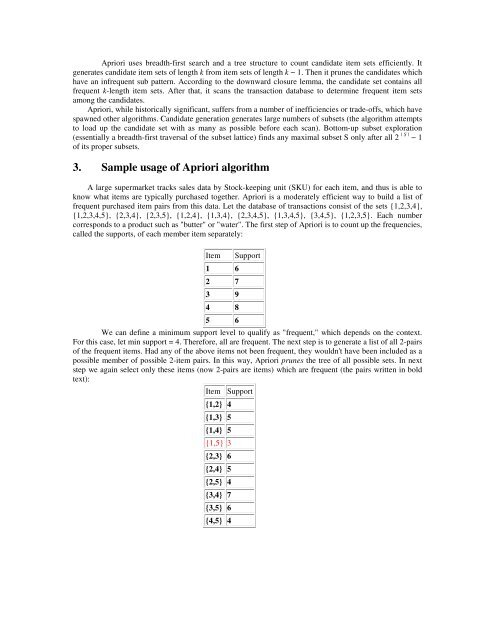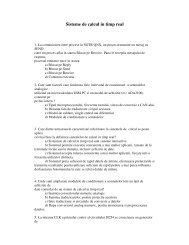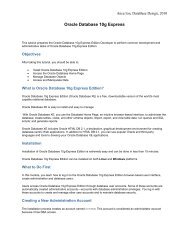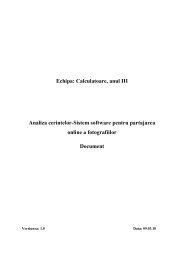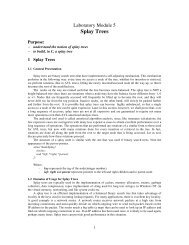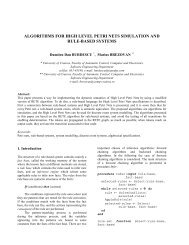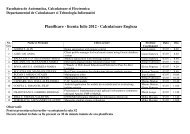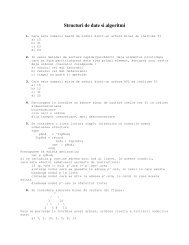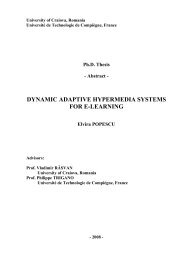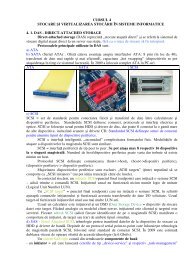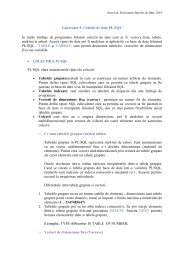Mining Frequent Itemsets – Apriori Algorithm
Mining Frequent Itemsets – Apriori Algorithm
Mining Frequent Itemsets – Apriori Algorithm
Create successful ePaper yourself
Turn your PDF publications into a flip-book with our unique Google optimized e-Paper software.
<strong>Apriori</strong> uses breadth-first search and a tree structure to count candidate item sets efficiently. It<br />
generates candidate item sets of length k from item sets of length k − 1. Then it prunes the candidates which<br />
have an infrequent sub pattern. According to the downward closure lemma, the candidate set contains all<br />
frequent k-length item sets. After that, it scans the transaction database to determine frequent item sets<br />
among the candidates.<br />
<strong>Apriori</strong>, while historically significant, suffers from a number of inefficiencies or trade-offs, which have<br />
spawned other algorithms. Candidate generation generates large numbers of subsets (the algorithm attempts<br />
to load up the candidate set with as many as possible before each scan). Bottom-up subset exploration<br />
(essentially a breadth-first traversal of the subset lattice) finds any maximal subset S only after all 2 | S | − 1<br />
of its proper subsets.<br />
3. Sample usage of <strong>Apriori</strong> algorithm<br />
A large supermarket tracks sales data by Stock-keeping unit (SKU) for each item, and thus is able to<br />
know what items are typically purchased together. <strong>Apriori</strong> is a moderately efficient way to build a list of<br />
frequent purchased item pairs from this data. Let the database of transactions consist of the sets {1,2,3,4},<br />
{1,2,3,4,5}, {2,3,4}, {2,3,5}, {1,2,4}, {1,3,4}, {2,3,4,5}, {1,3,4,5}, {3,4,5}, {1,2,3,5}. Each number<br />
corresponds to a product such as "butter" or "water". The first step of <strong>Apriori</strong> is to count up the frequencies,<br />
called the supports, of each member item separately:<br />
Item<br />
1 6<br />
2 7<br />
3 9<br />
4 8<br />
5 6<br />
Support<br />
We can define a minimum support level to qualify as "frequent," which depends on the context.<br />
For this case, let min support = 4. Therefore, all are frequent. The next step is to generate a list of all 2-pairs<br />
of the frequent items. Had any of the above items not been frequent, they wouldn't have been included as a<br />
possible member of possible 2-item pairs. In this way, <strong>Apriori</strong> prunes the tree of all possible sets. In next<br />
step we again select only these items (now 2-pairs are items) which are frequent (the pairs written in bold<br />
text):<br />
Item Support<br />
{1,2} 4<br />
{1,3} 5<br />
{1,4} 5<br />
{1,5} 3<br />
{2,3} 6<br />
{2,4} 5<br />
{2,5} 4<br />
{3,4} 7<br />
{3,5} 6<br />
{4,5} 4


